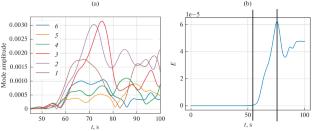圆柱形通道内液态金属多向旋转MHD流动的相互作用
IF 0.48
Q4 Physics and Astronomy
Bulletin of the Russian Academy of Sciences: Physics
Pub Date : 2025-07-16
DOI:10.1134/S1062873825711894
引用次数: 0
摘要
用数值方法研究了由电磁力产生的两个反向旋转涡流之间的圆柱形槽内混合层的稳定性。描述了不稳定发展过程中的流动。由此产生的开尔文-亥姆霍兹不稳定性成为小扰动的来源,并导致液体的湍流混合。第二和第三种流动模式对扰动的发展贡献最大。本文章由计算机程序翻译,如有差异,请以英文原文为准。

Interaction between Multi-Directional Rotating MHD Flows of Liquid Metal in a Cylindrical Channel
The stability of the mixing layer in a cylindrical cell between two counter-rotating vortex flows created by electromagnetic forces is investigated numerically. The flow is described during the development of instability. The resulting Kelvin–Helmholtz instability becomes a source of small disturbances and leads to turbulent mixing of the liquid. The second and third modes of flow make the greatest contribution to the development of disturbances.
求助全文
通过发布文献求助,成功后即可免费获取论文全文。
去求助
来源期刊

Bulletin of the Russian Academy of Sciences: Physics
Physics and Astronomy-Physics and Astronomy (all)
CiteScore
0.90
自引率
0.00%
发文量
251
期刊介绍:
Bulletin of the Russian Academy of Sciences: Physics is an international peer reviewed journal published with the participation of the Russian Academy of Sciences. It presents full-text articles (regular, letters to the editor, reviews) with the most recent results in miscellaneous fields of physics and astronomy: nuclear physics, cosmic rays, condensed matter physics, plasma physics, optics and photonics, nanotechnologies, solar and astrophysics, physical applications in material sciences, life sciences, etc. Bulletin of the Russian Academy of Sciences: Physics focuses on the most relevant multidisciplinary topics in natural sciences, both fundamental and applied. Manuscripts can be submitted in Russian and English languages and are subject to peer review. Accepted articles are usually combined in thematic issues on certain topics according to the journal editorial policy. Authors featured in the journal represent renowned scientific laboratories and institutes from different countries, including large international collaborations. There are globally recognized researchers among the authors: Nobel laureates and recipients of other awards, and members of national academies of sciences and international scientific societies.
 求助内容:
求助内容: 应助结果提醒方式:
应助结果提醒方式:


